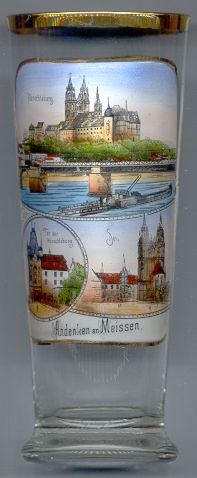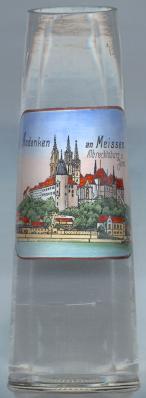

|
| DEUTSCHLAND | GERMANY |
| Bundesland: Freistaat Sachsen | Saxony |
| Landkreis: Meißen |
Meißen is situated on the river Elbe about 25 km northwest of Dresden.
Its history goes back to the castle Misni founded in AD 929 on a hill near the left bank of the river by King Heinrich I. The margraviate Meißen was founded in 965.
The Wettin family came in possession of the margraviate in 1089 (see chart of the Wettin dynasty).
Since then, Meißen always played an important part in Saxony's history.
As the castle was seat of the margraves (later dukes and electors) and also that of the bishops, Meißen became an important trading place.
The village below the castle was founded in 1150. By 1326 it had obtained the status of a town. The residence was moved to Dresden in 1500.
During the Thirty Years' War (1618–1648), about 50% of the town was destroyed. The industrial development of the 19th century initiated a long period of growth.
From 1901 on, areas on the right bank of the Elbe became part of the city. After World War II, the historic parts of the town were neglected.
Since the reunification of Germany in 1989, extensive renovation works are in progress.


 The castle
The castle  Albrechtsburg [centre] dates from the last building period on the castle hill.
It was erected in Late Gothic style from 1471 on as the first residential castle of Germany. Most parts of the castle were
completed in 1489, the last parts were finished in 1524. However, the castle rarely was used as a real residence after the Saxon court moved to
Dresden. In 1676, Elector Johann Georg II of Saxony named the castle Albrechtsburg for Duke Albrecht 'the Stout-hearted',
founder of the Albertine line of the Wettin family. In 1710, Elector Friedrich August I (August II 'the Strong' as King of Poland) founded the
first procellain manufacture of Europe in the castle after Johann Friedrich Böttger had discovered a recipe for porcellain. For some 150 years the
famous Meißen porcellain manufacture was located in the castle. After it had moved to a new location in the town in 1863, the castle was renovated
and received splendid interior decorations in Historicist style. Since then it is a museum.
Albrechtsburg [centre] dates from the last building period on the castle hill.
It was erected in Late Gothic style from 1471 on as the first residential castle of Germany. Most parts of the castle were
completed in 1489, the last parts were finished in 1524. However, the castle rarely was used as a real residence after the Saxon court moved to
Dresden. In 1676, Elector Johann Georg II of Saxony named the castle Albrechtsburg for Duke Albrecht 'the Stout-hearted',
founder of the Albertine line of the Wettin family. In 1710, Elector Friedrich August I (August II 'the Strong' as King of Poland) founded the
first procellain manufacture of Europe in the castle after Johann Friedrich Böttger had discovered a recipe for porcellain. For some 150 years the
famous Meißen porcellain manufacture was located in the castle. After it had moved to a new location in the town in 1863, the castle was renovated
and received splendid interior decorations in Historicist style. Since then it is a museum.
The  cathedral of Meißen [background] on the castle hill was built in Gothic style between around 1250
and about 1400. The two west towers of the 14th century were heightened in Neo-Gothic style in 1904–1908. Friedrich I 'the Warlike', first Elector of Saxony,
built the burial chapel of the Wettin family in 1428 in front of the west portal of 1370. The altar painting in St. George's chapel
was painted by Lucas Cranach the Elder in 1534. The altar of the Cross dating from 1526 also was made in Cranach's workshop.
Seven sculptures, two of them depicting Emperor Otto I and his wife Adelheid, the founders of the bishopric of Meißen,
date from the 13th century and are attributed to the Master of Naumburg or his workshop
cathedral of Meißen [background] on the castle hill was built in Gothic style between around 1250
and about 1400. The two west towers of the 14th century were heightened in Neo-Gothic style in 1904–1908. Friedrich I 'the Warlike', first Elector of Saxony,
built the burial chapel of the Wettin family in 1428 in front of the west portal of 1370. The altar painting in St. George's chapel
was painted by Lucas Cranach the Elder in 1534. The altar of the Cross dating from 1526 also was made in Cranach's workshop.
Seven sculptures, two of them depicting Emperor Otto I and his wife Adelheid, the founders of the bishopric of Meißen,
date from the 13th century and are attributed to the Master of Naumburg or his workshop
In 1399, Pope Boniface IX declared the bishopric 'exempt' and placed it under direct authority of the Holy See
In 1533, during the Reformation, the diocese effectively ceased to exist and was placed under the administration of the
Electorate of Saxony. All its monasteries and convents were secularised. In 1921 Pope Benedict XV recreated the diocese
with its new seat in Bautzen. In 1980 the seat of the bishops was moved to
Dresden. Since then, the diocese now is called Dresden-Meißen.
![[scale]](lineal.jpg)